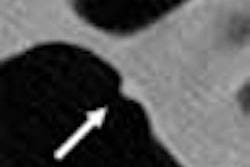SAN DIEGO - Radiologists from Bogotá, Colombia are reporting great success with CT-guided spinal diagnosis and intervention for patients with low back pain. According to their results, presented Tuesday at the American Roentgen Ray Society meeting, nearly all of their patients responded well to the procedure, which may delay the need for more invasive surgery.
Dr. Sonia Bermudez and Dr. Diego Aguirre from the Fundación SantaFe de Bogotá Medical Center included 111 patients in their study, which began in February 2002 and ended in April 2003. The authors also are affiliated with El Bosque University in Bogotá.
The patients presented with a variety of back-related issues including degenerative disk (40% of the patients) and facet joint disease (44%). Symptoms included numbness and severe pain that radiated to the legs, hip, and groin areas.
Under CT management, the authors performed a variety of block procedures, such as periradicular infiltrations, facet joint blocks, nerve root blocks, epidural injections, and sacroiliac joint blocks.
The patients were placed in a prone position inside the CT gantry and percutaneous CT scans were performed for localization. A 2-gauge needle was used to inject the painful area with a combination of long-term and short-term anesthetic drugs as well as anti-inflammatory steroids.
"The idea is to put the needle as near as possible to the facet joint space," Aguirre said. The majority of patients, 58%, had the procedure done bilaterally, he added.
In total, the authors performed 222 blocks in 111 patients, average age 62. The procedure time was 15 minutes per block. Patients were asked to assess their pain levels before, immediately following, and nine months after the procedure on a scale of 0-10 (10=maximum pain).
According to the results, before undergoing the procedures, the average pain score was 6.6; immediately following the interventions, the score dropped to 3.2; at follow-up, it was at 3.4, Aguirre said.
After the procedure, 95% of the patients reported good to moderate improvement in their low back pain symptoms. Nine months later, 96% of the patients said they were pain-free. Only four of the 111 patients required additional spinal surgery for pain control. There was one complication during an epidural block, Aguirre said, when an intradural injection resulted in a transient motor deficit.
Aguirre said that CT-guided intervention for low back pain could be used in complement with traditional treatment methods such as rest, oral administration of non-steroidal anti-inflammatory drugs (NSAIDS), physical therapy, and spinal manipulation.
An added benefit of CT intervention over surgery is that it can be performed without patient sedation, he said.
Spinal CT imaging received another boost in a second ARRS presentation on Tuesday. A group from Harvard Medical School in Boston suggested that CT should replace x-ray for the diagnosis of cervical spine trauma. They also found the former modality to be more efficient and cost-effective.
"This is the first study to show that CT can completely replace plain films, and result in a cost savings," said presenter Mykol Larvie, Ph.D., a senior medical student at Harvard. Larvie’s co-authors are Drs. James Rhea, Robert Novelline, and Daniel Rosenthal from Harvard and Massachusetts General Hospital.
For this study, the group evaluated emergency department C-spine imaging from 1992 to 2001 at the university’s level 1 trauma center. They looked at utilization trends and the relative diagnostic yield and costs of radiography and CT.
In 2001, there were 1,131 x-ray exams performed vs. 1,908 CT scans, Larvie reported. In addition, plain exams had a low incidence of true-positive findings (0.50%) compared to CT (5.85%). The incidence of false-positive findings on x-ray was 3.7 times greater than true-positive findings, Larvie said. Finally, the direct cost of C-spine CT imaging ($68.41) was 16% lower than that of the x-ray exam ($81.49).
By Shalmali PalAuntMinnie.com staff writer
May 6, 2003
Plain film x-rays not needed with CT to evaluate polytrauma spinal injuries, December 6, 2002
Spinal cord injuries often missed in initial trauma assessment, September 26, 2002
Whole-body CT preferred to chest x-ray, ultrasound in trauma patients, January 21, 2002
Canadian c-spine rule could safely reduce radiography use, October 7, 2001
Studies and practice shape CT's role in c-spine trauma, August 28, 2001
Copyright © 2003 AuntMinnie.com



















